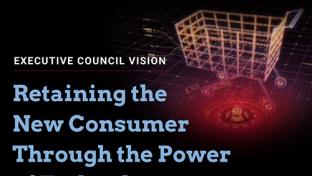Boosting Supply Chain Challenges Through Advanced Technologies: Up Close with Zebra Technologies' Guy Yehiav
As the consumer goods and retail industries continue to grapple with myriad supply chain challenges, technologies like artificial intelligence are playing a meaningful role in helping companies overcome some of their biggest roadblocks.
We checked in with Guy Yehiav, general manager of Zebra Analytics at Zebra Technologies and a member of the CGT/RIS Executive Council, to get his perspective on the promise of AI in retail and consumer goods, as well as some of the ways companies are leveraging prescriptive analytics right now.
Yehiav, an active member of the retail and CG tech communities, also shared insights on where more work needs to be done when it comes to retail and CG collaboration — something tech can’t solve but has the potential to improve and unlock new possibilities when all parties are willing to embrace it.
RIS: You're a longtime advocate of the business benefits of prescriptive analytics, often writing to educate the industry about the competitive edge it can bring. How has the adoption rate progressed since the onset of the pandemic, and what's needed to further advance progress?
The adoption rate has increased in several areas. First, from an employee training perspective, businesses reduced the amount of peer-to-peer training to keep employees safe from COVID-19 —opting to leverage prescriptive analytics instead. There was a substantial increase in hiring new personnel, which drove more on-the-job training, protocol compliance monitoring, and operational efficiency assessments.
EC Member Shares
How long have you been with Zebra?
This past June marked my two-year anniversary as General Manager of Zebra Analytics, which started after Zebra’s acquisition of Profitect. I founded Profitect in June 2010.
What has been your “pandemic pastime?”
Learning the guitar. I’ve always wanted to do it, but I’m naturally left-handed. I recently had the opportunity to try a lefty guitar, which was much easier than the regular one. I’ve also enjoyed cycling and skiing with my wife and daughters, as well as reading books.
Where are you looking forward to traveling?
Personally, vacationing in Bermuda or Anguilla. For business, I’m looking forward to returning to Europe and Australia to re-connect with our partners!
Favorite Netflix/Amazon/Hulu binge series?
On Netflix, I’d have to say my favorite show has been “Schitt's Creek.” It’s absolutely hilarious! I’ve also enjoyed watching the Israeli television series “Fauda.”
Which book is on your nightstand or to-do list?
I actually have two books waiting for me on my nightstand: “Think Again” by Adam Grant and “Leadership Strategy and Tactics” by Jocko Willink.
Supply chain disruptions created another opportunity to leverage prescriptive analytics throughout the end-to-end value chain in order to identify anomalies (both demand and supply change risk) and alleviate them as early as possible to prevent delays, out-of-stocks and poor customer service. Prescriptive analytics is helping improve resiliency throughout the value chain.
RIS: What are some of the biggest misconceptions when it comes to leveraging prescriptive analytics within retail and consumer goods?
The primary misconception is that prescriptive analytics is a reporting system that generates a lot of false positives and takes too long to implement. Typically, when we speak with executives from retail or CPG, they start the conversations by saying they are planning and have a lot of artificial intelligence and machine learning algorithms everywhere.
However, when they learn about the differences between prescriptive analytics and smart-machine reporting, they realize that the former generates much more value for their business. It arms employees with actionable insights that enable them to maximize their productivity through streamlined workflows.
RIS: Zebra recently announced plans to acquire Antuit.ai to expand its analytics, AI and automation capabilities, marking its third such acquisition in two years. How do you expect it to benefit the company in both the near and long term?
Through its synergies with our retail store execution portfolio, the acquisition of Antuit.ai will further drive our ability to bring the power of artificial intelligence to our customers and meet evolving consumer demands. It will also enable us to offer an automated advanced analytics solution to CPG customers that links to our manufacturing portfolio — supporting more efficient planning, operations and execution with greater efficiency and visibility across the supply chain, elevating supply chain resiliency as a priority.
RIS: Where do you see the most promise for AI's use in retail and consumer goods?
Artificial intelligence and machine learning are what allows the algorithm to optimize the outcomes based on feedback loops and real-time data loaded into the solution. I believe the use of these techniques will continue to evolve from solely planning and execution to personalization and anticipation of demand and business outcomes.
If you have planning accuracy, you can link the demand sensing with what is actually happening by anticipating consumer trends in shorter time increments. It helps build a stack that aligns with “reality” on a second-by-second basis.
From a personalization standpoint, it will enable organizations and service providers to provide a very unique customer experience. That solution will work across retail, healthcare, restaurants, entertainment, CPG and other verticals. Its advanced technology will create an enhanced level of demand-driven supply networks unlike anything we’ve ever seen before.
RIS: A recurring topic of conversation within the Executive Council is the need for increased retail and CG collaboration. What's your perspective on the progress that's been made since the onset of COVID-19?
In the past 20 years, businesses were talking about collaboration, but weren’t actually collaborating. As a result, out-of-stocks continue to be a major issue — especially on promotional items. The pandemic exposed the lack of collaboration, as well as the fact that resiliency was not a priority.
Supply chain latency is impacting all brands and retailers today. I believe the collaboration will receive a boost from technology.
RIS: Where would you like to see more work done, and what will be required?
For better collaboration, we need to think about it on multiple levels:
- Business alignment: Get the merchants, the supply chain and the IT departments communicating with each other to create priorities and bite-size projects with clear objectives and value.
- Technology needs to enable planning and execution through a restricted type of security, but also allow the flexibility of multiple product hierarchies. The hierarchies’ retailers are currently using make little sense for the brand teams. I recently wrote about the topic here.
RIS: As we head into Q4, can you make any retail predictions for 2022?
I believe supply chain latency will continue for the next few months. As such, it will demand increased collaboration between manufacturing sites, supply chains and retailers. I also believe supply chains will create efficiencies through the use of collaborative robotics (Cobots) to streamline workflows for employees.
Brick-and-mortar stores will play a larger role. Just look at Amazon opening more physical stores. We’ll likely see other online-only retailers opening stores. However, these stores will provide better customer service, making the store visit more personalized for the average consumer.








